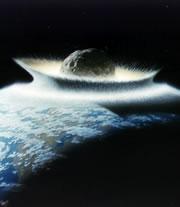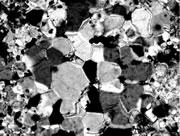 Giant asteroids usually disintegrate on impact - but not always, it seems.© NASA
Giant asteroids usually disintegrate on impact - but not always, it seems.© NASAA soccer-ball-sized chunk of a several-kilometre-wide asteroid has been found deep inside an ancient crater in South Africa. Finding such a large piece of a huge impactor is extremely rare, since these speeding giants are usually almost completely destroyed when they crash into the Earth.
The Earth's atmosphere helps to decelerate smaller meteorites as they plummet to the ground, leaving intact remnants that can occasionally be several metres across. "But the big guys have so much mass they don't really feel the Earth's atmosphere at all," explains Phil Bland, a meteorite expert at Imperial College London. This means that until now, the biggest preserved remnants of these kilometre-wide space rocks have been little more than pebbles, and scientists have tended to rely on traces of rare metals at an impact site to work out the composition of the original asteroid.
The meteorite was found in the Morokweng impact crater in South Africa, which is more than 70 kilometres wide and thought to be some 145 million years old. The discovery is reported by Wolf Maier of the University of Quebec at Chicoutimi, Canada, and his colleagues in this week's Nature1.
Hidden treasure
 A close-up of the minerals in the ancient meteorite.© Nature
A close-up of the minerals in the ancient meteorite.© NatureThe crater was discovered only in the mid-1990s because it was hidden by a covering of sand, explains Lewis Ashwal, a geologist at the University of the Witwatersrand, Johannesburg, South Africa, and part of the team led by his Witwatersrand colleague Marco Andreoli.
Morokweng's unusual gravitational and magnetic profile has allowed scientists to map the crater, and mining drills have probed the twisted rock at the base of the crater that was melted by the impact.
"In one of the drill cores we found a big chunk of something," recalls Ashwal. The drill had sliced through the 25-centimetre-wide meteoric lump at a depth of 766 metres; it could be identified as a separate bit of rock by its unusual texture and chemical make-up. "Inside a big impact melt it's virtually unknown to see pieces of the meteorite that struck," says Ashwal.
ADVERTISEMENT
The sheer size of the rock means that many more scientists should be able to study the material, simply because there is more to share around, adds Bland, who was not part of the research team.
The scientists also discovered several smaller fragments less than a centimetre across throughout the sheet of melted rock. This means that scientists should be able to work out whether the materials in the original asteroid were evenly distributed, or whether it was made of clumps of distinctly different minerals.
Ashwal hopes that the find will encourage other scientists to drill into the impact melts of other large craters: "There may be more of this stuff down there," he says.
Visit our survivorunearthed.html">newsblog to read and post comments about this story.
-
References
- Maier W. D., et al. Nature, 441. 203 - 206 (2006). | Article |
